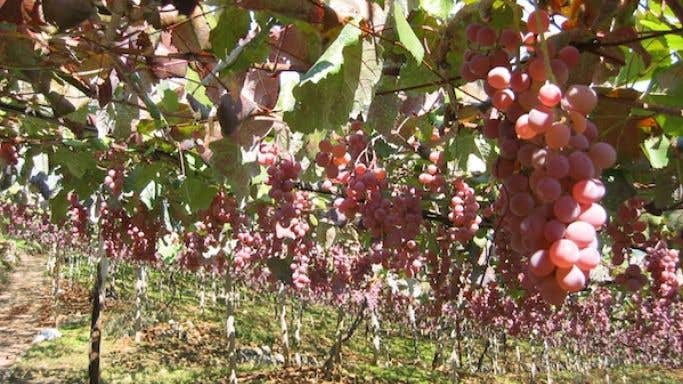Australian Denis Gastin who has long taken a special interest in Asian domestic wine production sends this report of last month’s Japan Wine Competition, an assessment of the current state of the Japanese wine industry.
I was very pleased to be judging again at the JWC, at which I have been privileged to have been a judge every year except one since the very first event in 2003. [Denis is second from left on the back row in the picture of him and his fellow judges of the hybrids category below.]

For me it is a great opportunity to update myself on what is happening in the wine industry in Japan. The fact is that Japan is quite different from the traditional wine-producing countries with its considerable range of climate and soil factors, from the very cold far north to the semi-tropical far south. Naturally, this produces wines that are different from conventional western styles – and this difference is taken to another level altogether with the unique varieties that have been developed in Japan and are now more widely used in viticulture and wine production.
I was really pleased to be judging the hybrid category and blends again. It is a real adventure for me. Below are my impressions of the wines submitted, by category.
Hybrids and other reds
I have been watching this category develop for over 20 years now, and judging this category at the JWC has provided me with the opportunity to understand it much more comprehensively.
There has been great progress in style development over this time, especially with Muscat Bailey A – now the most widely planted hybrid, with the potential, I believe, to do for Japanese red wine what Koshu (picture growing in Yamanashi prefecture above right) has done for white. There is a very diverse style profile – from lightly coloured, light-bodied rosés, some slightly sweet, all the way through to very deep-coloured, very dry, extractive wines with extensive oak fermentation and maturation.
Black Queen and Kai Noir are particularly interesting blending options, particularly with Muscat Bailey A, giving more depth and expression to the palate. There were a lot more entries this year of Yamabudo (a wild mountain grape) hybrids, both as stand-alone varieties and in blends. Almost 20 entries had some Yamabudo component. I find Yama Sauvignon (a cross with Cabernet Sauvignon) an exciting variety giving a unique character to Japanese wines that will eventually attract international attention.
Red blends
I was interested to note this year the positive impact of classic varieties – especially Cabernet Sauvignon and Merlot – in blended red wines, both in this category and in the Hybrid and other reds category. Cabernet gives a really good structural boost to lighter-style Muscat Bailey A, providing a firmer finish. Merlot gives a softer and more gentle fruit character to some blends, especially with varieties such as Kai Noir and Black Queen that can be a bit severe as varietal wines.
Labrusca reds
I was particularly impressed with the Campbell Early entries this year. It is a variety that I think makes very good lighter-style wines – with an appealing aroma that consumers really enjoy.
It was the only labrusca variety that made it through from the primary evaluation round to the final assessment in this category. It is good to see the number of entries of this variety growing and the standard improving as well – though I personally think drier versions of Campbell Early are more attractive than semi-sweet.
Extremely sweet wines
I think that there is an over-reliance on added sugar in this category – not just this year, but each year that I have judged it. Where the added sugar is excessive, the only fruit impression is on the aroma. Then it disappoints when the fruit flavour is eliminated on the palate by the rich syrupiness that comes from excessive added sugar.
The Kerners had good aromas but that did not follow through to the palate. The one wine that really appealed to my palate was a Steuben, which was marked up to gold in the final round.
In this category you expect to find wines that have intensely concentrated fruit characteristics, either from botrytis or from grapes semi-dried on the vines. This was not the case with these entries – though the Steuben did have some vine-dried fruit characteristics.
Below are the award-winning wines.
-7.jpg)
